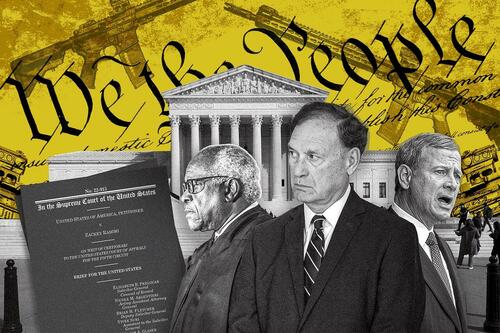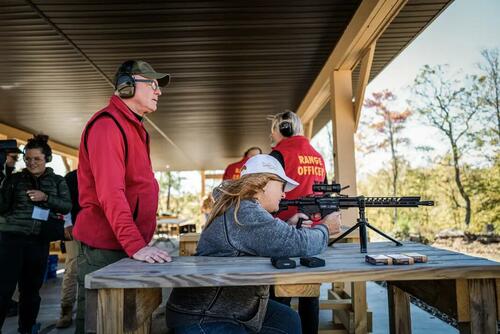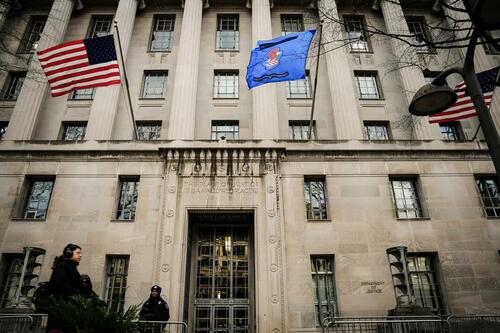
Authored by Michael Clements via The Epoch Times (emphasis ours),

Both sides of the Second Amendment debate will be watching the U.S. Supreme Court closely in 2024 as it applies the standards from previous decisions to new high-profile cases.
In the 2022 New York State Rifle and Pistol Association v. Bruen decision, the Supreme Court ruled that, to be constitutional, new gun laws must match the plain text of the Constitution and the “history and tradition” of the United States.
“The test that ... applies today requires courts to assess whether modern firearms regulations are consistent with the Second Amendment’s text and historical understanding,” Justice Clarence Thomas wrote for the majority in June 2022.
One of the first major post-Bruen cases, United States v. Rahimi has court watchers curious about how Bruen will be applied. The high court heard oral arguments on Rahimi on Nov. 7, 2023.
Federal law currently bars those who are under domestic violence restraining orders from possessing guns. The Supreme Court in the Rahimi case will decide if it stays or goes.
Gun control advocates say the “text and tradition” standard of the Bruen decision, if applied in Rahimi, would allow violent abusers access to guns, resulting in the deaths of domestic violence victims.
“The Supreme Court must reverse this dangerous [Bruen] ruling,” Janet Carter, senior director of issues and appeals at Everytown Law, wrote on the Everytown for Gun Safety website. “Domestic abusers do not have—and should not have—the constitutional right to possess a firearm.”
Gun rights advocates say the Rahimi case has been mischaracterized as an attempt to arm violent criminals when it’s really about protecting society without preemptively suspending constitutional rights.

“It’s going to answer one issue, which is, do we as a country have a historical tradition of disarming people that we believe to be dangerous?” William Kirk, a Washington state-based lawyer who specializes in the Second Amendment, told The Epoch Times.
“And the answer is, ‘Yes, we do.’”
Second Amendment lawyers predict that the Supreme Court will uphold the federal domestic violence law in Rahimi. They hope that the court will also ensure that due process rights are protected and an avenue for returning confiscated firearms is preserved.
“The real issue being decided goes far beyond the narrow question,” Tom Grieve, a Wisconsin criminal defense lawyer, told The Epoch Times.
Mark Smith, a constitutional attorney and author, agreed. He said it’s vital that the court protect the due process rights of gun owners.
“The most important thing Second Amendment supporters should want the Supreme Court to state in the Rahimi case is that the government may not disarm any American citizen unless there is first and foremost a court finding that a person is violently dangerous, after a robust evidentiary hearing with counsel, live witnesses, and ample due process,” he wrote in an email to The Epoch Times.
According to court records, Zackey Rahimi is a drug dealer based in Arlington, Texas, who abused his girlfriend and had a penchant for shooting at people when he was angry.
In 2019, he was placed under a domestic violence restraining order that barred him from possessing or purchasing firearms. Mr. Rahimi reportedly agreed to the order during a court hearing. He later assaulted a different woman and was involved in at least five more shootings, court records show.
He was indicted by a federal grand jury in the U.S. District Court for the Northern District of Texas for violating the restraining order after police found guns, drugs, and cash in his home.
He asked the Court of Appeals for the 5th Circuit, which covers Texas, Louisiana, and Mississippi, to toss the indictment because the restraining order was issued before he was convicted of any of the crimes for which the order was issued.
The court upheld the indictment. He pleaded guilty to violating the restraining order and was sentenced to 73 months in prison.
After the Bruen decision, the 5th Circuit reversed its decision, according to a petition filed by the Department of Justice (DOJ).

“The Fifth Circuit at first affirmed [the indictment], reasoning that its decision in McGinnis foreclosed Rahimi’s Second Amendment challenge. But after this Court decided New York State Rifle & Pistol Association v. Bruen, the Fifth Circuit withdrew its opinion. After receiving supplemental briefing on Bruen, the court reversed,” the petition reads.
The 5th Circuit ruled that, under the Bruen standard, 18 USC 922 (g) (8), which relates to unlawful possession of a firearm, didn’t align with the text of the Second Amendment and that there was no historical analog to indicate that the law was in line with the United States’ history and tradition of firearms regulation.
The court ruled that Mr. Rahimi had been deprived of his Second Amendment rights.
Define ‘Dangerous’
DOJ lawyers told the court that the 5th Circuit had misread the Bruen decision.
At that time, Republican-appointed Chief Justice John Roberts asked Mr. Rahimi’s lawyer, J. Matthew Wright, “You don’t have any doubt that your client is a dangerous person, do you?”
When Mr. Wright said it depends on what was meant by ‘dangerous person,’ the chief justice responded with, “Well, it means someone who’s shooting, you know, at people. That’s a good start,” according to The Associated Press.
However, Justice Samuel Alito, a Bush appointee, expressed concern that someone could receive a domestic violence restraining order without “any finding of dangerousness” before losing their Second Amendment rights.
“Now, suppose someone is later prosecuted for violating that provision. Would it be a defense for that person to say that the state law in question did not require such a finding and, in fact, there was no such finding in my case?” he asked U.S. Solicitor General Elizabeth Prelogar.
Mr. Kirk, who also hosts a YouTube channel focused on Second Amendment issues, expects the court to be particular in its decision.
“It’s going to be a narrow, tailored opinion, and it’s going to answer one issue, which is, do we as a country have a historical tradition of disarming people that we believe to be dangerous? And the answer to that question is, ‘yes, we do,’” Mr. Kirk told The Epoch Times.

While he agrees with Mr. Kirk on what the court will likely decide, Mr. Grieve said that the bigger question is how the justices will come to their conclusions.
“There’s a lot of ways this can go, right and wrong. And I think we may see a mixture of both,” he said.
Mr. Grieve pointed out that under Bruen’s text requirement, the justices will need to determine the definition of “the people.”
“What are the limits of the phrase ‘the right of the people?’ Is it just law-abiding citizens? Is it everyone?” he said.
The justices will also have to determine what constitutes “tradition.” How far back do they have to trace a law’s lineage before it can be considered a tradition?
Conflicting Ideas on Tradition
According to Mr. Grieve, many gun control advocates point out that the Second Amendment was incorporated into the states under the Constitution’s 14th Amendment, which guarantees equal protection under the law.
But most gun rights activists say tradition requires the court to consider the law in the context of the year that the Constitution was ratified, 1791. At that time, there were far fewer gun regulations.
“There is seemingly no end to the directions this could be going,” Mr. Grieve said.
And while it’s not as significant in the Rahimi case, some gun rights advocates expect due process to be a factor.
This was evidenced by Justice Alito’s question about whether “a finding of dangerousness” should be required before firearms are confiscated.
Aidan Johnston, director of federal affairs for Gun Owners of America, said this is crucial since many state red flag laws don’t have any due process requirements. He said this could result in the disarming of people who need protection during contentious divorce proceedings.
“Often, an innocent victim is deprived of the right to defend themselves. The Second Amendment is actually about empowering the victims,” Mr. Johnston told The Epoch Times.
Read more here...
Authored by Michael Clements via The Epoch Times (emphasis ours),

Both sides of the Second Amendment debate will be watching the U.S. Supreme Court closely in 2024 as it applies the standards from previous decisions to new high-profile cases.
In the 2022 New York State Rifle and Pistol Association v. Bruen decision, the Supreme Court ruled that, to be constitutional, new gun laws must match the plain text of the Constitution and the “history and tradition” of the United States.
“The test that … applies today requires courts to assess whether modern firearms regulations are consistent with the Second Amendment’s text and historical understanding,” Justice Clarence Thomas wrote for the majority in June 2022.
One of the first major post-Bruen cases, United States v. Rahimi has court watchers curious about how Bruen will be applied. The high court heard oral arguments on Rahimi on Nov. 7, 2023.
Federal law currently bars those who are under domestic violence restraining orders from possessing guns. The Supreme Court in the Rahimi case will decide if it stays or goes.
Gun control advocates say the “text and tradition” standard of the Bruen decision, if applied in Rahimi, would allow violent abusers access to guns, resulting in the deaths of domestic violence victims.
“The Supreme Court must reverse this dangerous [Bruen] ruling,” Janet Carter, senior director of issues and appeals at Everytown Law, wrote on the Everytown for Gun Safety website. “Domestic abusers do not have—and should not have—the constitutional right to possess a firearm.”
Gun rights advocates say the Rahimi case has been mischaracterized as an attempt to arm violent criminals when it’s really about protecting society without preemptively suspending constitutional rights.

“It’s going to answer one issue, which is, do we as a country have a historical tradition of disarming people that we believe to be dangerous?” William Kirk, a Washington state-based lawyer who specializes in the Second Amendment, told The Epoch Times.
“And the answer is, ‘Yes, we do.’”
Second Amendment lawyers predict that the Supreme Court will uphold the federal domestic violence law in Rahimi. They hope that the court will also ensure that due process rights are protected and an avenue for returning confiscated firearms is preserved.
“The real issue being decided goes far beyond the narrow question,” Tom Grieve, a Wisconsin criminal defense lawyer, told The Epoch Times.
Mark Smith, a constitutional attorney and author, agreed. He said it’s vital that the court protect the due process rights of gun owners.
“The most important thing Second Amendment supporters should want the Supreme Court to state in the Rahimi case is that the government may not disarm any American citizen unless there is first and foremost a court finding that a person is violently dangerous, after a robust evidentiary hearing with counsel, live witnesses, and ample due process,” he wrote in an email to The Epoch Times.
According to court records, Zackey Rahimi is a drug dealer based in Arlington, Texas, who abused his girlfriend and had a penchant for shooting at people when he was angry.
In 2019, he was placed under a domestic violence restraining order that barred him from possessing or purchasing firearms. Mr. Rahimi reportedly agreed to the order during a court hearing. He later assaulted a different woman and was involved in at least five more shootings, court records show.
He was indicted by a federal grand jury in the U.S. District Court for the Northern District of Texas for violating the restraining order after police found guns, drugs, and cash in his home.
He asked the Court of Appeals for the 5th Circuit, which covers Texas, Louisiana, and Mississippi, to toss the indictment because the restraining order was issued before he was convicted of any of the crimes for which the order was issued.
The court upheld the indictment. He pleaded guilty to violating the restraining order and was sentenced to 73 months in prison.
After the Bruen decision, the 5th Circuit reversed its decision, according to a petition filed by the Department of Justice (DOJ).

“The Fifth Circuit at first affirmed [the indictment], reasoning that its decision in McGinnis foreclosed Rahimi’s Second Amendment challenge. But after this Court decided New York State Rifle & Pistol Association v. Bruen, the Fifth Circuit withdrew its opinion. After receiving supplemental briefing on Bruen, the court reversed,” the petition reads.
The 5th Circuit ruled that, under the Bruen standard, 18 USC 922 (g) (8), which relates to unlawful possession of a firearm, didn’t align with the text of the Second Amendment and that there was no historical analog to indicate that the law was in line with the United States’ history and tradition of firearms regulation.
The court ruled that Mr. Rahimi had been deprived of his Second Amendment rights.
Define ‘Dangerous’
DOJ lawyers told the court that the 5th Circuit had misread the Bruen decision.
At that time, Republican-appointed Chief Justice John Roberts asked Mr. Rahimi’s lawyer, J. Matthew Wright, “You don’t have any doubt that your client is a dangerous person, do you?”
When Mr. Wright said it depends on what was meant by ‘dangerous person,’ the chief justice responded with, “Well, it means someone who’s shooting, you know, at people. That’s a good start,” according to The Associated Press.
However, Justice Samuel Alito, a Bush appointee, expressed concern that someone could receive a domestic violence restraining order without “any finding of dangerousness” before losing their Second Amendment rights.
“Now, suppose someone is later prosecuted for violating that provision. Would it be a defense for that person to say that the state law in question did not require such a finding and, in fact, there was no such finding in my case?” he asked U.S. Solicitor General Elizabeth Prelogar.
Mr. Kirk, who also hosts a YouTube channel focused on Second Amendment issues, expects the court to be particular in its decision.
“It’s going to be a narrow, tailored opinion, and it’s going to answer one issue, which is, do we as a country have a historical tradition of disarming people that we believe to be dangerous? And the answer to that question is, ‘yes, we do,’” Mr. Kirk told The Epoch Times.

While he agrees with Mr. Kirk on what the court will likely decide, Mr. Grieve said that the bigger question is how the justices will come to their conclusions.
“There’s a lot of ways this can go, right and wrong. And I think we may see a mixture of both,” he said.
Mr. Grieve pointed out that under Bruen’s text requirement, the justices will need to determine the definition of “the people.”
“What are the limits of the phrase ‘the right of the people?’ Is it just law-abiding citizens? Is it everyone?” he said.
The justices will also have to determine what constitutes “tradition.” How far back do they have to trace a law’s lineage before it can be considered a tradition?
Conflicting Ideas on Tradition
According to Mr. Grieve, many gun control advocates point out that the Second Amendment was incorporated into the states under the Constitution’s 14th Amendment, which guarantees equal protection under the law.
But most gun rights activists say tradition requires the court to consider the law in the context of the year that the Constitution was ratified, 1791. At that time, there were far fewer gun regulations.
“There is seemingly no end to the directions this could be going,” Mr. Grieve said.
And while it’s not as significant in the Rahimi case, some gun rights advocates expect due process to be a factor.
This was evidenced by Justice Alito’s question about whether “a finding of dangerousness” should be required before firearms are confiscated.
Aidan Johnston, director of federal affairs for Gun Owners of America, said this is crucial since many state red flag laws don’t have any due process requirements. He said this could result in the disarming of people who need protection during contentious divorce proceedings.
“Often, an innocent victim is deprived of the right to defend themselves. The Second Amendment is actually about empowering the victims,” Mr. Johnston told The Epoch Times.
Read more here…
Loading…





